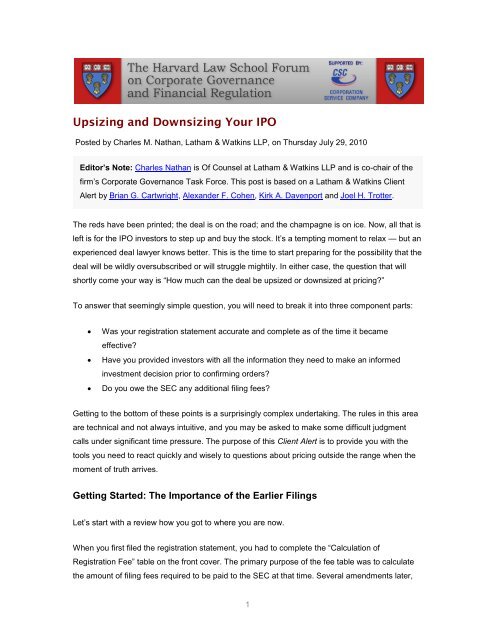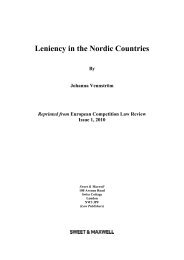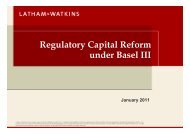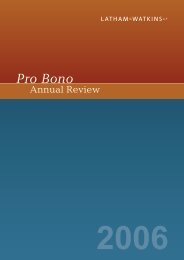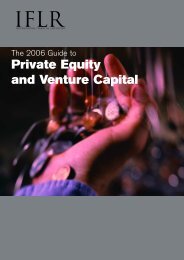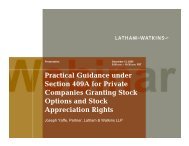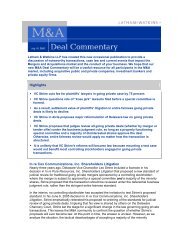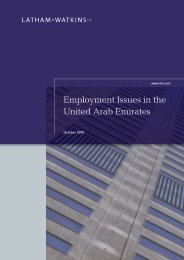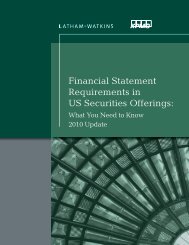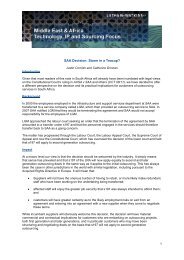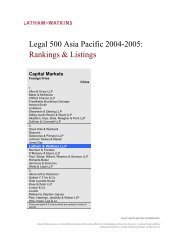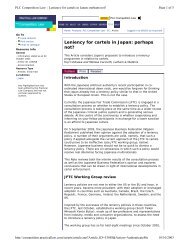Upsizing and Downsizing Your IPO - Latham & Watkins
Upsizing and Downsizing Your IPO - Latham & Watkins
Upsizing and Downsizing Your IPO - Latham & Watkins
You also want an ePaper? Increase the reach of your titles
YUMPU automatically turns print PDFs into web optimized ePapers that Google loves.
when your deal was ready to go to investors, a preliminary prospectus was filed showing thenumber of shares expected to be sold <strong>and</strong> a ―bona fide‖ estimate of the price range per share asrequired by Regulation S-K Item 501(b)(3). That range was very likely a $2 range, in keeping withthe informal SEC Staff policy for deals expected to price below $20 per share (if the upper limit isabove $20 per share, the informal policy is that a price range of up to 10 percent of the upper limitis bona fide). The price range prospectus was circulated to investors at the beginning of the roadshow.Now, the deal is on the road. Investor feedback is rolling in. If investor dem<strong>and</strong> is stronger thananticipated, the issuer <strong>and</strong> the selling stockholders may want to sell more shares or increase theprice per share being sold, or both. On the other h<strong>and</strong>, if a crisis in some far-away part of theworld happens to come to roost while your deal is on the road, the underwriters may have tostruggle to complete a smaller deal, involving fewer shares or a lower price per share, or both.Let’s review the tools in your toolbox for upsizing or downsizing your deal.Options Prior to EffectivenessUntil your registration statement has been declared effective by the SEC, you can revise yourdeal all you want in a pre-effective amendment with a new price range <strong>and</strong>/or a new number ofsecurities to be sold. You may need to pay additional filing fees if you are upsizing, but it’s noproblem to do so. If dem<strong>and</strong> is through the roof, this may be an option to consider.However, using a pre-effective amendment to upsize or downsize a deal after the price rangeprospectus has been distributed to investors is typically a last resort in our experience. Amongother things, there can be unwelcome timing implications (for example, you will need to obtain anew auditor’s consent <strong>and</strong> updated signature pages <strong>and</strong> clear any comments from the SEC Staffon the new disclosure). In addition, the new filing containing the amended price range could senda signal to the market about pricing that may be premature. Particularly for deals that are introuble <strong>and</strong> may need to be downsized, refiling the registration statement with a revised pricerange can spell disaster.Options After EffectivenessThose who qualify for the special treatment offered by Rule 430A <strong>and</strong> the related rules will find itmuch more attractive to make the necessary changes to the terms of the deal aftereffectiveness. 1 In most cases, therefore, the question for the deal team will be whether the1 Remember, though, that there are situations in which you may conclude that filing a pre-effective amendmentis unavoidable. One example would be where you are certain before effectiveness that your deal is going to be2
proposed changes to the number of shares to be sold <strong>and</strong> the price per share qualify for Rule430A’s magic? Put another way, the key question is this:―Assuming we go effective on a registration statement containing the same price rangeprospectus that was circulated to investors, how far can the deal be upsized or downsized atpricing <strong>and</strong> after effectiveness without having to go back to the SEC for permission?‖In order to underst<strong>and</strong> the magic of Rule 430A, you will need to master the interplay betweenseveral key provisions of the Securities Act <strong>and</strong> a number of rules <strong>and</strong> Compliance <strong>and</strong>Disclosure Interpretations (C&DIs) published by the SEC Staff. Once you have mastered theserules, you will need to answer these three questions:Is the ―Section 11 file‖ complete as of the effective time of the registration statement?Is the ―Section 12 file‖ complete as of the time you want to start confirming orders?Do you owe the SEC any more filing fees?Section 11 <strong>and</strong> Section 12Let’s start with a few words about the primary liability provisions of the Securities Act.Section 11(a) of the Securities Act imposes liability if any part of a registration statement, at thetime it became effective, ―contained an untrue statement of a material fact or omitted to state amaterial fact required to be stated therein or necessary to make the statements therein notmisleading.‖ Section 11 liability only covers statements made in a registration statement ateffectiveness. We think of the registration statement at the magic moment of effectiveness as the―Section 11 file.‖ This is a helpful way to remember that Section 11 is a highly technical provision,in the sense that it looks only at: (a) what is or is deemed to be in the registration statement (b) atthe time it became effective. 2By contrast, Section 12(a)(2) of the Securities Act is not limited to the registration statement <strong>and</strong>is not linked to the moment of effectiveness. It imposes liability on any person who offers or sellsa security in a registered offering by means of a prospectus, or any oral communication, whichdramatically downsized or upsized: failing to refile exposes you to the risk of tripping over Regulation S-K Item 501(b)(3),which requires an <strong>IPO</strong> issuer to include a ―bona fide estimate‖ of the price range in the preliminary prospectus it circulatesto potential investors. In the ordinary course, you would seek to go effective at some point prior to the close of the stockmarket — 2:00 p.m. Eastern time is often chosen. Because the market has not yet closed, you would typically not be in aposition to know with certainty that you will be pricing outside the range set forth in the prospectus at that time.2 The time of ―effectiveness‖ is a key moment in the <strong>IPO</strong>. Among other things, securities cannot be sold until theregistration statement is declared effective. Rule 430A allows an <strong>IPO</strong> to price as many as 15 business days aftereffectiveness, but it is most common to price on the day of effectiveness (which is also the time the underwriters will beginconfirming orders). The actual closing of the transaction happens some number of days later.3
contains ―an untrue statement of a material fact or omits to state a material fact necessary inorder to make the statements, in the light of the circumstances under which they were made, notmisleading.‖ Section 12(a)(2) is less technical <strong>and</strong> more holistic than Section 11. Section 12(a)(2)takes into account all oral statements, free writing prospectuses <strong>and</strong> statements in the pricerange prospectus, rather than focusing exclusively on the registration statement.Under Securities Act Rule 159 (which we discuss in greater detail below), Section 12 looks to thesum of what investors have been told at the time the underwriters confirm orders. Section 12’sfocus, therefore, is the price range prospectus sent to investors <strong>and</strong> any additional informationthat may have been conveyed to investors (orally or in writing) on or before the time of pricing.We think of this collection of information as the ―Section 12 file.‖In order to deal with all of the issues that arise in the context of changing the size <strong>and</strong> price of an<strong>IPO</strong> after the registration statement has been declared effective, you will need to keep in mindboth your ―Section 11 file‖ <strong>and</strong> your ―Section 12 file.‖Rule 430ARule 430A is a very special rule. It permits a registration statement to be declared effectivewithout containing final pricing information. Instead, it allows you to insert information retroactivelyinto a registration statement <strong>and</strong> have it be treated as if it were there as of its effective date. Rule430A provides that pricing-related information (which includes the price per share <strong>and</strong> the numberof shares offered) that is contained in a prospectus filed pursuant to Rule 424(b) aftereffectiveness of the registration statement will be deemed to have been part of the registrationstatement as of the effective date. In other words, Rule 430A allows you to tinker with your―Section 11 file‖ after the fact <strong>and</strong> have the changes travel backwards in time.Rule 430A is a particularly useful tool for complying with Section 11, <strong>and</strong> we are going to reviewall of its glorious twists <strong>and</strong> turns below. Keep in mind, however, Rule 430A’s two importantlimitations. First, it only applies to pricing information. 3 And second, Rule 430A does not help youmake corrections to your ―Section 12 file,‖ as it does not allow you to retroactively add to theinformation actually given to investors at the time of pricing.3 Rule 430A defines pricing information as:information with respect to the public offering price, underwriting syndicate (including any materialrelationships between the registrant <strong>and</strong> underwriters not named therein), underwriting discounts orcommissions, discounts or commissions to dealers, amount of proceeds, conversion rates, call prices<strong>and</strong> other items dependent upon the offering price, delivery dates, <strong>and</strong> terms of the securities dependentupon the offering date[.]4
Here is a summary of Rule 430A from a 40,000 foot perspective:If you are…Then youshoulduse…And you can…But you would need to…<strong>Upsizing</strong> yourdealInstruction toRule 430A(a)Increase the price per share<strong>and</strong>/or number of shares, solong as the aggregate size ofthe revised deal does notexceed 120 percent of theamount shown in the fee table inthe registration statement at thetime of effectiveness• File an immediately effectiveregistration statement underRule 462(b) to register theincrease in shares/increase indeal size (or a post-effectiveamendment if the increase isgreater than 20 percent)• Consider whether additionaldisclosure (oral or by meansof a free writing prospectus)needs to be delivered topurchasers prior toconfirmation of sale<strong>Downsizing</strong>your dealC&DI 627.01Decrease the price per share<strong>and</strong>/or decrease the number ofshares sold, so long as the sizeof the revised deal is not lessthan the lower end of the dealsize reflected in the price rangeprospectus minus 20 percent ofthe maximum deal size reflectedin the price range prospectus• Consider whether additionaldisclosure (oral or by meansof a free writing prospectus)needs to be delivered topurchasers prior toconfirmation of saleNow that you have the big picture, let’s go through it again at a more granular level.Instruction to Rule 430A(a)Rule 430A’s most important contribution to pricing outside the range is found in the instruction toparagraph (a), which states (in full):Instruction to Paragraph (a). A decrease in the volume of securities offered orchange in the bona fide estimate of the maximum offering price range from thatindicated in the form of prospectus filed as part of a registration statement that isdeclared effective may be disclosed in the form of prospectus filed with theCommission pursuant to Rule 424(b) or Rule 497(h) under the Securities Act solong as the decrease in the volume or change in the price range would notmaterially change the disclosure contained in the registration statement ateffectiveness. Notwithst<strong>and</strong>ing the foregoing, any increase or decrease in volume(if the total dollar value of securities offered would not exceed that which wasregistered) <strong>and</strong> any deviation from the low or high end of the range may bereflected in the form of prospectus filed with the Commission pursuant to Rule424(b)(1) or Rule 497(h) if, in the aggregate, the changes in volume <strong>and</strong> pricerepresent no more than a 20 percent change in the maximum aggregate5
offering price set forth in the “Calculation of Registration Fee” table in theeffective registration statement. [Emphasis added.]In other words, where the 20 percent safe harbor threshold is not exceeded, changes in price <strong>and</strong>deal size can be poured backwards in time into the registration statement using a Rule 424(b)filing of the final prospectus after the effectiveness of the registration statement <strong>and</strong> will bedeemed to have been part of the registration statement at the time it became effective forpurposes of Section 11. This is a very useful device indeed. It allows you to change the size ofyour deal by 20 percent in either direction without having to go back to the SEC. This timingadvantage is critical when you are trying to price a deal. Having to go back to the SEC to get apost-effective amendment declared effective is often not consistent with holding a book of orderstogether (particularly in the context of a deal that is being downsized). As a result, underst<strong>and</strong>ingthe exact scope of this 20 percent safe harbor is critical.C&DI 227.03 (January 26, 2009)C&DI 227.03 reads (in full) as follows:Question: A registrant omits pricing information from the prospectus in aregistration statement at the time of effectiveness in reliance on Rule 430A. Is itrequired to reflect pricing information or the inclusion of additional securities in apost-effective amendment?Answer: The second sentence of the Instruction to Rule 430A provides that aRule 424(b) prospectus supplement may be used, rather than a post-effectiveamendment, when the 20% threshold is not exceeded, regardless of themateriality or non-materiality of resulting changes to the registrationstatement disclosure that would be contained in the Rule 424(b)prospectus supplement. When there is a change in offering size or deviationfrom the price range beyond the 20% threshold noted in the second sentence ofthe Instruction, a post-effective amendment would be required only if suchchange or deviation materially changes the previous disclosure. Regardless ofthe size of the increase, in the case of a registration statement that is not anautomatic shelf registration statement, a new registration statement must be filedto register any additional securities that are offered. Additional securities cannotbe registered by post-effective amendment except on automatic shelf registrationstatements. [Emphasis added.]This C&DI establishes two important points:For purposes of Rule 430A (<strong>and</strong> hence the Section 11 file), retroactive changes in pricewithin the 20 percent threshold can be made after the fact by way of a Rule 424(b)prospectus even if the effects of those changes are material, <strong>and</strong>Even changes outside the 20 percent threshold can be made using a Rule 424(b)prospectus if the changes do not materially change the disclosure.6
These are important points — <strong>and</strong> not entirely intuitive — so let’s spend another minute here.Rule 430A effectively lets you make pricing-related changes to your registration statement withoutSEC review (i.e., without filing a post-effective amendment) even if those changes are material.This special privilege is limited to pricing information as contemplated by Rule 430A, but it is avery special privilege nevertheless. The second point is equally important — changes in excessof 20 percent may not be material (<strong>and</strong> hence may not require SEC review of a post-effectiveamendment).How can this be, you ask? Good question. Consider, for example, a $1 billion offering that is halfprimary <strong>and</strong> half secondary shares. If the secondary shares are reduced to $250 million, but theprimary shares stay at $500 million, the offering has been reduced by 25 percent but thereduction may well not be material. There will still be a very substantial public ―float‖ after theoffering <strong>and</strong> the proceeds to the issuer (<strong>and</strong> hence the use of proceeds), the pro forma number ofshares outst<strong>and</strong>ing <strong>and</strong> the pro forma earnings per share will not change at all. This sort of factpattern is right in the center of C&DI 227.03’s fairway.C&DI 627.01 (April 24, 2009)So far, so good. It all seems pretty clear — Rule 430A allows you to go up or down 20 percentfrom the maximum aggregate offering price reflected in the fee table. But one key questionremains unresolved:What does Rule 430A have to say about the deal size actually reflected in the prospectuscirculated to investors, as opposed to the maximum deal size reflected in the fee table? What if(as is often the case) these two amounts are not aligned?This is where C&DI 627.01 comes into play. C&DI 627.01 reads (in full) as follows:627.01 The instruction to paragraph (a) of Rule 430A provides that changes involume <strong>and</strong> price representing no more than a 20% change in the maximumoffering price set forth in the registration statement fee table may be madepursuant to a Rule 424(b)(1) prospectus supplement. The 20% threshold maybe calculated using the high end of the range in the prospectus at the timeof effectiveness <strong>and</strong> may be measured from either the high end (in the caseof an increase in the offering price) or low end (in the case of a decrease inthe offering price) of that range. [Emphasis added]C&DI 627.01 permits you to calculate the 20 percent amount for purposes of downsizing yourdeal in a very favorable way. As an alternative to the 20-percent-of-the-amount-in-the-fee-tableapproach contemplated by the instruction to paragraph (a) of Rule 430A, C&DI 627.01 allows youto derive your 20 percent amount by multiplying the upper end of the range in the price range7
prospectus by 20 percent. 4 You can then add that amount to the upper end of the range in theprice range prospectus if you are upsizing, or subtract that amount from the bottom of the range ifyou are downsizing, to figure out what share count <strong>and</strong> price per share will be within the safeharbor. Since 20 percent of the upper end of the price range is by definition greater than 20percent of the lower end of the price range, C&DI 627.01 effectively broadens the scope of theRule 430A safe harbor for troubled deals.The approach in C&DI 627.01 represents an alternative to the approach in the instruction toparagraph (a) of Rule 430A, <strong>and</strong> the SEC Staff takes the positions that you cannot ―mix <strong>and</strong>match‖ between the C&DI <strong>and</strong> the instruction to paragraph (a). As a result, if you are followingC&DI 627.01 you may not take 20 percent of the amount reflected in the fee table <strong>and</strong> subtractthat from the lower end of the price range, even though that might yield a lower floor on yourtransaction than 20 percent of the upper end of the range (since the fee table often registers alarger transaction than the upper end of the range). Either you calculate using the fee table or youcalculate using the range in the price range prospectus, but you can’t have it both ways. Inpractice, this means that you will want to use C&DI 627.01 when downsizing <strong>and</strong> the instructionto paragraph (a) of Rule 430A when upsizing.The Section 12 File <strong>and</strong> the Importance of Common SenseKnowing whether you are within the Rule 430A safe harbor is not the end of the analysis — afterall, the Rule contemplates that there could be material changes to the disclosure that would fallwithin the safe harbor. Rule 430A is a fabulous tool for dealing with the Section 11 file, but itdoesn’t help you with the Section 12 file. Let’s tackle the Section 12 file now.Securities Act Rule 159; Free Writing Prospectuses; Exchange Act Rule 15c2-8(b)Rule 159, which was introduced as part of the securities offering reforms that became effective in2005, adds an important wrinkle to the Section 12 l<strong>and</strong>scape. Rule 159 makes clear that, forpurposes of Section 12, information conveyed to a securities purchaser after the time of saledoes not count for purposes of determining whether the Section 12 file was complete at themoment that liability attaches. In other words, Section 12 liability is a function of what you actuallygave or told the purchaser prior to confirming the order — anything delivered after the moment oftruth does not count.This means that those material pricing changes that can be retroactively poured into the Section11 file after the fact under Rule 430A must actually be conveyed to purchasers in real time prior4 We’re assuming that the prospectus at effectiveness is the same price range prospectus circulated toinvestors — in other words, that you have not refiled with a different range.8
to confirming orders in order for the Section 12 file to be up to snuff. There are a number of waysto transmit the required information — the rules are agnostic as to the actual method ofconveyance — but the key point is that the conveyance must be made <strong>and</strong> it must be made priorto confirming orders.Market practice is that simple information that can be effectively reduced to sound bites isconveyed orally. It is customary in deals pricing within the range, for example, to convey the finalpricing information orally. Oral conveyance is also used in many upsizing <strong>and</strong> downsizingscenarios. The easiest example of this would be a 20 percent decrease in deal size in an allsecondaryoffering by a selling stockholder. All the investor needs to know in that case is howmany shares are being sold <strong>and</strong> at what price — there are no collateral disclosure implications tothe change in deal size in that example. 5 The disclosure in the price range prospectus will nototherwise change at all.More complicated deal changes may require that a free writing prospectus summarizing thechanges be circulated to accounts in writing as contemplated by Rule 433. An example of thissituation might be a decrease in offering size that results in a change to the use of proceedsflowing through the pro formas. The decision whether to convey the new information orally or inwriting will in part depend on whether the price range prospectus circulated to investors contained―sensitivity analysis‖ explaining how the company’s plans would change if the actual proceedsturned out to be more or less than the amount assumed in the price range prospectus. The moresensitivity analysis that is included in the price range prospectus, the more likely it will be possibleto convey the missing information orally at the time of pricing. This is a point to keep in mind inthe early drafting sessions.There is no hard-<strong>and</strong>-fast rule about how much sensitivity analysis will do, <strong>and</strong> what topics needto be covered. Some items to evaluate might include:Use of proceeds, particularly where stated uses would need to be changed or new usesadded (for example, in the case of unexpectedly large proceeds)Pro forma earnings per shareThe size of the ―float‖ after the offeringThe company’s financial condition generallyThe level of beneficial ownership by members of senior management or other significantstockholders; <strong>and</strong>Dilution.5 Note, however, that one consequence might be a material change to the ownership structure, for example ifthe change resulted in a control group’s retention (or loss) of control over the company.9
The goal is to have disclosure that allows investors to see how changes in share price or dealsize ripple through critical elements of the disclosure. Ideally, the price range prospectus willpresent key disclosures in an ―if/then‖ format (―We will apply the net proceeds from this offeringfirst to repay all borrowings under our credit facility <strong>and</strong> then, to the extent of any proceedsremaining, to general corporate purposes,‖ for example).Finally, where the changes are so fundamental that the original price range prospectus must becompletely rewritten, it may be necessary to recirculate a completely new price range prospectusin order to satisfy Exchange Act Rule 15c2-8(b). Rule 15c2-8(b) requires that brokers <strong>and</strong> dealersparticipating in an <strong>IPO</strong> ―deliver a copy of the preliminary prospectus to any person who isexpected to receive a confirmation of sale at least 48 hours prior to the sending of suchconfirmation.‖ [Emphasis added.]The line between a complete recirculation <strong>and</strong> a supplemental circulation of changed pages is ablurry one. The free writing prospectus concept introduced by Rule 433 in the 2005 securitiesoffering reforms was intended, we believe, to obviate the need for a full recirculation of acompletely new price range prospectus in all but the most extreme cases. However, whenchanged pages become so pervasive that the original price range prospectus can no longer besaid to be ―the preliminary prospectus‖ within the meaning of Rule 15c2-8(b), then a fullrecirculation may be required. If the changes are less than pervasive, a free writing prospectussummarizing the changes should suffice.The key import of this distinction between a full recirculation of a new price range prospectus <strong>and</strong>a supplemental circulation of a free writing prospectus summarizing the changes relates to timing.If you have tripped the Rule 15c2-8(b) wire, you need to give investors 48 hours (generallythought to mean two full business days) 6 to consider the revised disclosure. If you are in freewriting prospectus l<strong>and</strong>, however, you may conclude that investors only need a few hours (oreven minutes) to digest the new disclosure. The SEC Staff has, to date, refrained from offeringany guidance on the question ―How long is long enough?‖ as it relates to delivery of newinformation for purposes of Rule 159 <strong>and</strong> Section 12. The prevailing view among law firms is thatmost information can be digested upon receipt <strong>and</strong> only very complicated changes need a fullbusiness day to be absorbed. Somewhat complicated changes may need more than a fewminutes to be digested but less than a full business day.6 In other words, if prospective investors actually have the revised preliminary prospectus in their h<strong>and</strong>s at 9:00a.m. on Monday morning, it would be appropriate to price on Tuesday after the market closes.10
We continue to feel that the better view of Rule 433 <strong>and</strong> the free writing prospectus that itushered in is that a properly crafted <strong>and</strong> conveyed free writing prospectus should eliminate theneed for a full recirculation in all but the most extreme cases. 7Filing Fee Issues — Securities Act Rules 457 <strong>and</strong> 462(b)Rule 457Although Rule 457 deals with the seemingly mundane issue of the calculation of the registrationfee, the choice you make under Rule 457 will have a significant impact on your options at themoment of truth.Remember that you initially filed your registration statement with a fee table, calculated either:Under Rule 457(o) on the basis of the amount of proceeds the issuer wanted to raise, orUnder Rule 457(a) on the basis of the number of shares to be sold <strong>and</strong> a bona fideestimate of the sale price per share.Chances are, you opted to calculate the registration fee for purposes of the fee table under Rule457(o). You could have used Rule 457(a) instead, but since doing so would let the market knowthe likely per share price (i.e., maximum deal size divided by the number of shares registered),most deal teams opt to use Rule 457(o). 8 It’s unusual in our experience for a deal team to elect totip its h<strong>and</strong> about the expected price per share at the time the registration statement is first filed.7 One wrinkle in Rule 433 that could be construed to require a full recirculation in a very limited circumstancedeserves discussion. Rule 433(b)(2)(i) requires that an <strong>IPO</strong> issuer’s free writing prospectus be:accompanied or preceded by the most recent . . . [preliminary] prospectus [on file with the SEC]; provided,however, that use of the free writing prospectus is not conditioned on providing the most recent suchprospectus if a prior such prospectus has been provided <strong>and</strong> there is no material change from the priorprospectus reflected in the most recent prospectus[.]This proviso is puzzling, since in most cases there would not be a reason to circulate a free writing prospectus if therewere nothing material to report. We choose, therefore, to interpret the proviso as meaning that a free writing prospectusfor an <strong>IPO</strong> issuer is only allowed to convey material changes if the free writing prospectus <strong>and</strong> the original preliminaryprospectus (<strong>and</strong> each other broadly distributed free writing prospectuses, if any), taken together, contain materially thesame information as is at the time on file with the SEC. We think that this interpretation is more in keeping with the overallpurpose of Rule 433 — namely, to encourage sending information to accounts on an as-needed, real-time basis.In any event, however, note 1 to paragraph (b)(2)(i) of Rule 433 makes clear that this technical issue is not a problem fora free writing prospectus delivered by e-mail as long as it includes a hyperlink to the most recent preliminary prospectuson file with the SEC. As a result of this helpful note, every free writing prospectus to be sent by e-mail in connection withan <strong>IPO</strong> should include such a hyperlink. In situations where the underwriters are able to distribute free writingprospectuses to all accounts by e-mail, there is no need to struggle with the interpretive issue discussed in the priorparagraph.8 There is a technical reason why it is generally preferable to chose Rule 457(o) at the outset. The SEC Staffinformally takes the position that if you raise your price range in a preliminary prospectus contained in a pre-effectiveamendment from the range used to calculate the filing fee <strong>and</strong> you originally elected to proceed under Rule 457(a), thenthe 20 percent safe harbor contemplated by the instruction to paragraph (a) of Rule 430A is calculated on the basis of the11
When the time comes to file your price range prospectus, you have a choice: either keep usingRule 457(o), or refile your fee table under Rule 457(a).If you choose to refile under Rule 457(a), you will not have to pay more filing fees if your offeringprice per share later increases — that’s baked right into the text of the Rule. You will, however, berequired to pay additional filing fees if you later increase the number of shares to be offered, evenif the total offering size (number of shares sold times sale price) does not go above the originalestimate used to calculate the original filing fee. The added shares will need to be registered,either on an immediately effective registration statement under Rule 462(b) or via a post-effectiveamendment — we discuss below how that is done.If you stick with Rule 457(o), you will not have to file a new registration statement <strong>and</strong> payadditional filing fees if your per share price goes down <strong>and</strong> you increase the number of sharesoffered so as to maintain the original aggregate offering price. See C&DI 640.05. You will,however, be required to pay additional filing fees if you keep the same number of shares <strong>and</strong>increase the per share price (thereby increasing the aggregate deal size).Which route is preferable? Refiling under Rule 457(a) allows you to increase the price per share(but not the number of shares) without filing an additional registration statement or post-effectiveamendment. By contrast, staying with Rule 457(o) allows you to increase the number of shares<strong>and</strong> decrease the price per share so as to maintain overall deal size, without filing an additionalregistration statement or post-effective amendment. So it all boils down to whether you think youwill be upsizing price only (<strong>and</strong> leaving the number of shares unchanged) or will be playing withboth price <strong>and</strong> number of shares in order to keep the same total aggregate deal size. Many dealteams elect to switch to Rule 457(a) at the time of printing the price range prospectus, becauseincreasing the price per share at pricing is a more likely outcome than increasing the number ofshares <strong>and</strong> decreasing the price.Rule 462(b)How do you go about adding additional shares (if you are using Rule 457(a)) or increasing thedeal size (if you are using Rule 457(o))? You have two choices — either file an immediatelyoriginal maximum aggregate offering price <strong>and</strong> not the offering price range contained in the price range prospectusdistributed to investors. This qualification can be eliminated if you ―voluntarily‖ pay an additional filing fee when youincrease your offering range, but doing so defeats the primary benefit of Rule 457(a) (i.e., you do not need to go back tothe SEC if you increase your estimated price per share). This SEC Staff position can be a trap for the unwary issuer whoelected to use Rule 457(a) originally to calculate the filing fee <strong>and</strong> later seeks to upsize. There is no such hidden problemfor users of Rule 457(o), as they are required to pay additional filing fees at the time they upsize their deal, <strong>and</strong> they knowit.12
effective registration statement under Rule 462(b), or file a post-effective amendment <strong>and</strong> wait forthe SEC Staff to declare you effective. 9If you can qualify to use Rule 462(b), that is the better route — it eliminates the additional step ofclearing the post-effective amendment with the SEC Staff. 10 Rule 462(b) is available if: You file the new registration statement prior to the time confirmations are sent, <strong>and</strong> The increase in price <strong>and</strong> share count together represent an increase of no more than 20percent of the previous maximum aggregate offering price (as set forth in the fee table ateffectiveness).There is a curious wrinkle to how the 20 percent amount is calculated for purposes of Rule462(b), again depending on whether you refiled your fee table under Rule 457(a) or stayed withRule 457(o). If you are using Rule 457(a), you multiply the number of additional shares by thenew offering price <strong>and</strong> then look to see whether the increase in deal size associated with theadded shares is more or less than 20 percent of the deal size in the fee table at effectiveness —even though that fee table was calculated at the old price per share. See C&DI 640.03. To takean example, imagine that your fee table at effectiveness reflected 11.5 million shares <strong>and</strong> a pricerange of $8-$10 per share, for a maximum aggregate deal size of $115 million. At pricing, thenumber of shares is increased by 1.5 million <strong>and</strong> the price is increased to $12 per share. Thenumber of additional shares times the price equals $18 million. Since this is less than 20 percentof $115 million (i.e., $23 million), you could use Rule 462(b) to register the new shares. The factthat the entire deal is actually being upsized by more than 20 percent (since $115 million plus 20percent equals $138 million, <strong>and</strong> 13 million shares times $12 per share equals $156 million) isdisregarded if you are using Rule 457(a).The calculation is done differently if you are staying with Rule 457(o). In that case, you multiply allof the shares being offered (including the additional shares) by the new price per share <strong>and</strong> thenlook to see if you have increased total deal size by more than 20 percent. See C&DI 640.04. Thismakes sense, since Rule 457(o) looks to total deal size. To use our example above, 20 percent ofthe original maximum deal size equals $23 million. Because 13 million shares are being offered ata new price per share of $12, total deal size would be $156 million, which is more than theoriginal deal size plus 20 percent ($115 million plus $23 million equals $138 million). As a result,you could not use Rule 462(b) to register the additional deal size <strong>and</strong> would instead have to file apost-effective amendment.9 Whichever route is chosen, you will also need to remember to include a new Exhibit 5.1 opinion on the legalityof the additional securities being registered. This can be done by means of an immediately effective post-effectiveamendment under Rule 462(d).10 Note, by the way, that Rule 462(b) works for an increase in transaction size in a Rule 457(o) deal, eventhough the text of Rule 462(b) speaks only of ―registering additional securities.‖ See C&DI 640.04.13
Some Examples of How It All Fits TogetherIs your head spinning at this point? It should be. Let’s start with the following basic facts <strong>and</strong> thentry various upsizing <strong>and</strong> downsizing scenarios to help illustrate how the rules work:Maximum aggregate deal size in the fee table at effectiveness is $115 millionThe price range prospectus reflects a range of $8-$10 per share, 10 million firmcommitment shares <strong>and</strong> 1.5 million greenshoe shares, for a total of 11.5 million shares(including the greenshoe) 11The minimum aggregate deal size in the price range prospectus is $92 million (includingthe greenshoe), while the maximum aggregate deal size in the price range prospectus is$115 million (including the greenshoe)Scenario 1: At pricing, the price is increased to $12 but the number of shares stays thesame, for a total aggregate deal size of $138 million (post greenshoe).This is within Rule 430A’s safe harbor, because the increased price per share (from $10 to $12)when multiplied by the number of shares (10 million plus the 1.5 million greenshoe shares) yieldsa maximum aggregate deal size ($138 million) that does not exceed the maximum aggregateoffering size reflected in the fee table plus 20 percent ($115 million plus $23 million equals $138million). (You include the greenshoe shares in these calculations, because you need to haveregistered <strong>and</strong> paid fees for all securities sold in the offering.) You can ignore the price rangeprospectus for the moment, since the instruction to Rule 430A(a) says you look to the maximumdeal size in the fee table to calculate the 20 percent amount for purposes of upsizing. The feetable will always reflect a total deal size that is greater than or equal to the deal size reflected inthe price range prospectus (at least if you used Rule 457(o) to compute the fee table), so you cansee why the instruction is the way to go in an upsizing scenario — you get to calculate the 20percent off a bigger base <strong>and</strong> hence get a larger increase.Because you are within Rule 430A, the new deal size <strong>and</strong> share price will be deemed to be partof the Section 11 file at the time the registration statement became effective once the finalprospectus is filed under Rule 424(b). The Section 12 file can be h<strong>and</strong>led with an oral statementto accounts at the time of confirming orders to the effect that the price is now $12 per share <strong>and</strong>the maximum deal size is $138 million (post greenshoe). Ideally, the price range prospectus11 The ―greenshoe‖ is jargon for the underwriters’ over-allotment option — that is, the contractual right topurchase some number of additional shares from the issuer after the closing of the offering. ―It is so named because itwas first used in connection with a 1963 secondary offering of shares of common stock of The Green Shoe ManufacturingCompany, the Boston-based manufacturer of Stride-Rite shoes (not green shoes for leprechauns as some havesupposed).‖ Charles J. Johnson, Jr. <strong>and</strong> Joseph McLaughlin, Corporate Finance <strong>and</strong> the Securities Laws at 2-38 (4th ed.2009).14
already disclosed what the proceeds would be used for if the deal raised more cash thanoriginally assumed, so there is no need to elaborate on that point.There would be no need to pay additional fees via a Rule 462(b) registration statement if youcalculated your filing fee for purposes of the fee table using Rule 457(a), because the number ofshares to be sold has not changed — this, as we pointed out above, is the primary benefit of Rule457(a). If you calculated your filing fee using Rule 457(o), on the other h<strong>and</strong>, you would need toregister the additional deal size, <strong>and</strong> this could be done by filing a Rule 462(b) registrationstatement. 12Scenario 2: At pricing, the price is increased to $14 <strong>and</strong> the number of shares is increasedto 12 million (pre greenshoe) <strong>and</strong> 13.8 million (including the greenshoe), for a totalaggregate deal size of $193.20 million (post greenshoe).This is outside the Rule 430A safe harbor, since the new total maximum aggregate deal size($193.20 million) is more than 20 percent above the maximum deal size reflected in the fee table($115 million plus $23 million equals $138 million). That’s not the end of the story, of course.Remember that C&DI 227.03 permits you to pour this information back into the Section 11 file atthe time of effectiveness via a Rule 424(b) prospectus even if your deal size changes by morethan the 20 percent safe harbor amount, if the increase in deal size does not materially changethe disclosure. You might be able to conclude that the changes were immaterial — for example, ifthe sensitivity analysis in the price range prospectus gave investors enough information to trackthe changes through the disclosure — but in practice this may not matter since you may still needa post-effective amendment to register the additional deal size (as we explain below).Regardless of which approach is taken — Rule 424(b) prospectus or post-effective amendment— the Section 12 file will also need to be addressed. This can be done either with an oralstatement to accounts at the time of confirming orders or by distributing a Rule 433 free writingprospectus prior to confirming orders to those expected to purchase shares. The decisionwhether to convey the new information orally or in writing (via a free writing prospectus) willdepend on the complexity of the changes.Finally, don’t forget that you would need to register additional shares <strong>and</strong> pay additional fees,whether you used Rule 457(a) (since the number of shares being registered has increased) orRule 457(o) (as a result of the increase in transaction size). On our facts, if you refiled under Rule457(a) at the time of printing the price range prospectus you would not be able to register the12 When calculating the increase in deal size for Rule 462(b) purposes, do not overlook the underwriters’overallotment option – you will need to register a sufficient number of shares (<strong>and</strong> pay enough fees) to cover both theprimary as well as any option shares to be sold in the <strong>IPO</strong>.15
additional shares via an immediately effective Rule 462(b) registration statement, because theadditional number of shares (2.3 million) multiplied by the new price per share ($14) equals$32.20 million, which is more than 20 percent of the maximum offering price at effectiveness ($23million). Similarly, if you used Rule 457(o) you would have to file a post-effective amendment,since the increase in total deal size (from $115 million to $193.20 million) is greater than 20percent. In both cases, you would have to wait for the SEC Staff to declare your post-effectiveamendment effective before any sales are confirmed.Scenario 3: At pricing, the price is decreased to $6 but the number of shares stays thesame, for a total aggregate deal size of $69 million (post greenshoe).At first glance, this might appear to be outside the Rule 430A safe harbor since the new totalmaximum aggregate deal size ($69 million) is less than the maximum deal size reflected in thefee table minus 20 percent ($115 million minus $23 million equals $92 million). But rememberC&DI 627.01, which allows you to focus on the price range in the price range prospectus ratherthan the amount reflected in the fee table. Following C&DI 627.01, you would calculate the 20percent threshold by using the high end of the range (20 percent of $115 million equals $23million) <strong>and</strong> then deducting that amount from the low end of the range ($92 million). Thisapproach ($92 million minus $23 million) lets you reduce the deal to $69 million with thegreenshoe, <strong>and</strong> gives you maximum flexibility. C&DI 627.01 is your best choice in a downsizingscenario — you get to decrease deal size beyond the level that the instruction to Rule 430A(a)would otherwise allow. The decreased pricing information can be included in a Rule 424(b)prospectus <strong>and</strong> will be deemed to be part of the Section 11 file at effectiveness.The Section 12 file issues may well be more interesting in this example, depending in part onwhether the disclosure in the price range prospectus included sensitivity analysis explaining whatthe issuer would do if the deal got downsized to such an extent. If it did, an oral explanation of thesmaller deal size may be sufficient to provide investors with the missing information. If not,particularly if the use of proceeds will need to change, a free writing prospectus summarizing thechanges may be advisable.Because there is no increase in aggregate deal size or number of shares being offered, there isno need to pay additional fees or file a Rule 462(b) registration statement. In fact, the questionwhether additional filing fees are due never comes up in a downsizing scenario.16
Scenario 4: At pricing, the price is decreased to $4 but the number of shares is increased,for a total aggregate deal size of $69 million (post greenshoe).The answer to this scenario is the same as scenario 3, since both yield a minimum deal size of$69 million. In other words, the aggregate size of the deal did not decrease by more than 20percent (calculated using the C&DI 627.01 methodology) because of the increase in the numberof shares to be sold. We believe that the SEC Staff would consider this scenario to be within Rule430A, notwithst<strong>and</strong>ing the steep decrease in the per share price (from $8 to $4). 13Some Additional Things to Bear in MindNegative Assurance Letter PracticeNegative assurance letter practice among law firms changed following the adoption of theSecurities Act reforms in 2005, particularly because of Rule 159’s focus on the information ininvestors’ h<strong>and</strong>s at the time of pricing. Negative assurance letters now cover three importantitems:The registration statement as of its effective date, as measured against the requirementsof Section 11 of the Securities ActThe final prospectus, as of its date <strong>and</strong> as of the closing date, as measured against therequirements of Section 12 of the Securities Act, <strong>and</strong>The ―Pricing Time Disclosure Package‖ as of the time the underwriters commence toconfirm orders, as measured against the requirements of Section 12 of the Securities Act.This last bullet point was added to address Rule 159. It requires the negative assurance providedby the issuer’s <strong>and</strong> the underwriters’ law firms to speak to the collection of information conveyedto prospective purchasers at the time the underwriters begin to confirm orders. The magic of Rule430A <strong>and</strong> its permission to go back in time to rewrite history is critical for the negative assurancegiven in the first bullet point above, which relates to the Section 11 file, but it is of no use forpurposes of the third bullet point, which relates to the Section 12 file.The way to satisfy Rule 159 is to actually convey information to accounts. In the context of a dealthat is being upsized or downsized at the last minute, conveying information — or even preparingthe information so that it can be conveyed — may not be easy to do in a timely manner. As a13 Having said that, you would need to be comfortable that the price range in the price range prospectuscirculated to investors (<strong>and</strong> included in the registration statement at the time of effectiveness) was in fact a ―bona fide‖price range as required by Regulation S-K Item 501(b)(3).17
esult, the deal team will be under pressure to make important materiality judgments on a realtimebasis.FINRA Issues<strong>IPO</strong>s are subject to FINRA Rule 5110 (sometimes referred to as the Corporate Financing Rule).The underwriters of your <strong>IPO</strong> will be FINRA members, <strong>and</strong> the Corporate Financing Rule will limitthe amount of compensation they (<strong>and</strong> other distribution participants for that matter) may receivein connection with the <strong>IPO</strong>. The Corporate Financing Rule also prohibits certain practices thatFINRA has determined to be ―unfair or unreasonable‖ <strong>and</strong> contains filing <strong>and</strong> disclosurerequirements. 14If the type of compensation going to the underwriting group consists only of the ―spread‖ (i.e., thediscount off the public offering price), the upsizing or downsizing of an <strong>IPO</strong> should not triggeradditional issues under Rule 5110. However, Rule 5110 includes many other ―items of value‖received by the underwriters around the time of the <strong>IPO</strong> in the calculation of aggregateunderwriting compensation. If aggregate underwriting compensation exceeds a certainpercentage of the total offering proceeds, the underwriters may need to obtain the FINRA ―noobjections‖ opinion required by the SEC in order for the registration statement to be declaredeffective. A change in the size of your deal could potentially change the total underwritingcompensation as a percentage of deal proceeds in a manner that would require a visit to FINRA.In practice, that may be difficult to achieve under the timing pressure that always exists at themoment of truth.FINRA Rule 2720 contains additional requirements that apply to public offerings in which aparticipating FINRA member is deemed to have a ―conflict of interest‖ (i.e., an interest in theoutcome of the offering beyond its role as an underwriter or selling group member).The rule provides that a conflict of interest exists whenever five percent or more of the netoffering proceeds will be directed to a FINRA member or its affiliates or other ―related persons.‖Accordingly, if an offering is downsized, you will need to re-assess whether the conflict of interestprovisions of Rule 2720 are triggered. Among other things, Rule 2720 will generally require theparticipation of a FINRA-approved ―qualified independent underwriter‖ <strong>and</strong> inclusion of prominentdisclosure as to the nature of the conflict in the prospectus.14 Among other things, the Corporate Finance Rule limits the greenshoe to 15 percent of the amount ofsecurities being offered in the <strong>IPO</strong> (excluding the greenshoe). See FINRA Rule 5110(f)(2)(J).18
NYSE/Nasdaq IssuesBoth the NYSE <strong>and</strong> the Nasdaq’s listing rules exempt ―controlled companies‖ — that is,companies of which more than 50 percent of the voting power is held by an individual, a group oranother company — from certain listing requirements relating to corporate governance. Forexample, controlled companies are exempt from the requirement to have a board composed of amajority of independent directors. When you are doing an <strong>IPO</strong> for a controlled company, youshould keep an eye out for the potential effect of selling more shares on the controlled companyanalysis — if your deal is upsized at the moment of truth, it’s possible that the company will notlonger be ―controlled‖ for purposes of this exemption.Tying It All TogetherSo how does all of this fit together, you ask? Simple, really. The underwriters <strong>and</strong> the issuershould start the dialogue about how the market is reacting to the deal while the road show isprogressing. These are the types of questions that may come up:Is there sufficient dem<strong>and</strong> for the stock within the suggested range?If not, is it possible to get a smaller deal done within the range or may we need to reducethe deal’s size <strong>and</strong> the per share price?If the size of the deal decreases, will the use of proceeds need to change?Is there sufficient excess dem<strong>and</strong> that we can increase the price to a price that is abovethe top end of the range?Can we increase the price above the range <strong>and</strong> increase the number of shares beingoffered?If the deal size increases, what will the extra proceeds be used for?What did we say in the price range prospectus sent to investors about what wouldhappen to our use of proceeds if the deal were to be upsized or downsized?It is important to get this dialogue going long before it is time to price the deal so the deal teamcan plan for every possible outcome. Bear in mind that:A free writing prospectus reflecting new disclosures may need to be drafted <strong>and</strong>circulated to prospective investors expected to purchase stock in the offering beforeorders can be confirmed, or a telephone script for the conversation with those investorsmay need to be preparedA final prospectus containing appropriate disclosure must in any event be drafted <strong>and</strong>filed under Rule 424(b)19
The accountants’ comfort letters may need to change to reflect the revised disclosureA Rule 462(b) registration statement to register additional shares or transaction size mayneed to be prepared, <strong>and</strong> extra filing fees may need to be paidA Rule 462(d) post-effective amendment to add a new Exhibit 5.1 opinion coveringadditional shares may need to be drafted <strong>and</strong> filedIf there are other changes that do not qualify as pricing information within the meaning ofRule 430A or if Rule 430A’s 20 percent safe harbor is not available, a post-effectiveamendment to the registration statement may need to be prepared <strong>and</strong> filed, <strong>and</strong> theSEC Staff must declare it effective, <strong>and</strong>In the most extreme cases, an entirely new price range prospectus must be drafted <strong>and</strong>recirculated to all investors expecting to purchase stock in the offering.All these steps take time. There is no substitute for advance planning, which comes in twophases — before <strong>and</strong> during/after the road show. Before the road show, it is very h<strong>and</strong>y if theprice range prospectus is drafted to include appropriate sensitivity analysis along the linesdiscussed above. Good advance planning <strong>and</strong> carefully crafted disclosure in the price rangeprospectus may make it possible to conclude that a change in deal size is not a material changein the disclosure, taken as a whole. During <strong>and</strong> after the road show, as soon as it becomes clearthat an upsizing or downsizing is even a possibility, the deal team should be reviewing the optionsunder the rules described above <strong>and</strong> preparing revised disclosure, free writing prospectuses,telephone scripts, etc., as needed.Timing is critical <strong>and</strong> there is little margin for error. Be prepared!SummaryThis is tricky stuff. However, with appropriate advance planning <strong>and</strong> carefully crafted disclosure inthe price range prospectus, it is possible to navigate the many technical requirements <strong>and</strong> focuson the judgment calls. What is a material change to the disclosure depends in part on what wasdisclosed in the first instance, so the advance planning really begins at the first drafting session.Those who are thinking ahead to pricing from the very beginning will have an easier time whenthey get there, even if the deal changes materially at the moment of truth.20


